
16 minute read
ADIPEC throws the spotlight on hydrogen
ADIPEC throws the spotlight on
hydrogen
ADIPEC will provide a forum to share perspectives on how hydrogen can potentially deliver a clean, integrated approach to the Middle East and North Africa (MENA) region’s energy sector.
Green hydrogen is integral to the UAE’s plans for a sustainable energy future.
ACCORDING TO A recent Goldman Sachs report, green hydrogen could meet up to 25% of the world’s energy requirements in less than 30 years, with a market value in excess of US$10 trillion. To emphasise the importance of hydrogen in a diversified energy sector and address the challenges and opportunities of producing green and blue hydrogen on a mega industrial-scale, ADIPEC has dedicated seven sessions to hydrogen during its Strategic Conference.
The sessions will focus on critical industry topics such as building a sustainable hydrogen economy, establishing a policy framework to promote hydrogen deployment, repurposing value chains, managing supply and demand dynamics, and up-scaling.
Christopher Hudson, Global Energy president, dmg events, said, “ADIPEC 2021 will enable the global energy industry to gain key insights from, and share knowledge with the policymakers, technologists, scientists and companies at the forefront of the hydrogen industry and identify the new business models and strategies required to unlock, create and maximise value from hydrogen’s potential as a future clean energy source.”
Expert speakers participating in the ADIPEC hydrogen sessions include Dr Samir J. Serhan, COO, Air Products; Martin Houston, vice chairman, Tellurian; Dr Christoph Noeres, head of Green Hydrogen, Thyssenkrupp; John Kent, chief energy transition officer, Kent; Alicia Eastman, cofounder and president, InterContinental Energy; Paul Bogers, vice president –Hydrogen Shell; Andy Hemingway, president, Energy Optimisation & Innovation, Wood PLC; Brandon Spencer, president – Energy Industries, ABB; Daniel Teichmann, CEO, Hydrogenious; and Rod Christie, executive vice president of Turbomachinery & Process Solutions, Baker Hughes.
With governments across the globe implementing plans to decarbonise while ensuring affordable energy for all, ADIPEC provides an ideal platform for the UAE to showcase its commitment to net-zero carbon emissions by 2050 and its roadmap for a sustainable energy future, with green hydrogen production integral to its ambitions. This comes as the UAE is positioning itself as a low-cost producer and exporter of blue and green hydrogen, as well as green ammonia.
Work is already underway on megaprojects such as the two-gigawatt green ammonia project by Taqa, the Abu Dhabi National Energy Company, and Abu Dhabi Ports. The project will produce green hydrogen and process it into liquid ammonia, used in ships as bunker fuel and for export.
Meanwhile, the Khalifa Industrial Zone Abu Dhabi (Kizad) has announced plans for a US$1bn green ammonia plant, which will produce 200,000 tonnes of green ammonia from 40,000 tonnes of green hydrogen. "According to a recent report by Forbes, industry commentators agree that a price around US$2 per kilo of hydrogen could be pivotal,” said Hudson. “In addition, the UN Green Hydrogen Catapult project, which includes Saudi Arabia's Acwa Power, has agreed to halve the current cost of a kilo of green hydrogen to below US$2 by 2026 and increase the scale of production 50-fold." "So besides major investment, some of the key issues to be discussed at ADIPEC are the price of producing green hydrogen from renewable energy as well as how quickly new technology can be developed," he added. n
Leading in high-tech coiled tubing strings
ESTM IS THE only certified manufacturer of high-tech coiled tubing strings in Russia. We supply coiled tubing to more than 50 companies in Europe, the Middle East, Russia and CIS countries.
Coiled tubing (CT) is a continuously milled length of pipe used in advanced oil and gas production technologies. It is deployed in a well to perform workover and well intervention operations on oil and gas wells of various depth and direction. CT technologies are at the cutting edge of the petroleum industry as they have a number of key benefits over conventional drill pipes.
Coiled tubing avoids problems associated with connections and requires no assembly/disassembly of the drillstring. Also, pressure control equipment installed at the wellhead ensures safe operations under live well conditions. Furthermore, continuous coiled tubing gives access even to long lateral and horizontal wells. The market of CT technologies is constantly expanding.
ESTM makes continuously milled coiled tubes 1 inch to 3-1/2 inches in diameter and up to 25,000 feet long spooled on reels. The wall thickness ranges from 0.075 to 0.22 inch. We offer our clients both standard pipes and those featuring increased H2S resistance.
ESTM Quality Management System is certified to API Q1 and ISO 9001:2015, and our products are manufactured to API 5ST (API Monogram License No. 5ST-0010).
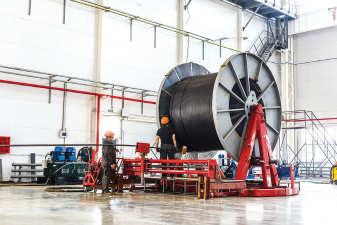
The ESTM plant.
Image Credit: ESTM
Coiled tubing is used in the
following operations: • Wellbore cleanout and well completion. • Acidising jobs. • Fracturing and multi-stage fracturing. • CT Logging. • Jet perforation.
We offer our clients the following
key advantages: • Lead time of only 14 days. • Low-alloy carbon steel strip from top Russian and global steelmakers. • Customised string design including tapered coiled tubing and pipes with e-line installed. • Convenient logistics. • The most popular sizes available off the shelf.

Driving value with
digital transformation
Digitisation is key to future-proofing the oil & gas industry and realising sustainability goals, say Alaa Elshimy, managing director and senior VP of Enterprise Business Group, Huawei Middle East, and Lv Gongxun, senior consultant, Global Energy Business Unit, Enterprise BG, Huawei.
GLOBAL DUAL-CARBON GOALS are bringing about change not only in energy, but also in the economic structure of energy-producing nations. They are driving changes in production technologies and lifestyles. They are also having a profound impact on the oil and gas industry, and are bound to trigger structural reforms on both supply and demand, propelling the industry's transformation and development.
According to the BP Energy Outlook 2020, global demand for primary energy will only continue to grow, and oil and gas will remain the primary energy source until 2035. Although the share of oil and gas consumption in all energy sources will decrease after that point, the total volume will remain relatively stable. We are confident about the future of the oil and gas industry.
At the same time, oil and gas companies still face significant challenges. First, in the context of the dual carbon goals, companies need to produce more energy at lower costs, while reducing carbon emissions. Second, oil and gas exploration targets are becoming increasingly difficult to achieve, with proven resources often falling short. Third, newly discovered oil and gas reserves are difficult to produce, which requires advanced exploitation technology. Fourth, in the medium and long term, the global oil and gas supply is already relatively sufficient, which means the low and median oil prices will remain.
Digital transformation is inevitable if the industry is to address these challenges efficiently and sustainably. Realising such change brings significant opportunities to oil and gas companies. Digital transformation can drive the reconstruction of business and management models and can facilitate the innovation of new models entirely. Ultimately, digitisation can help oil and gas companies evolve and increase value.
The oil and gas industry needs to further integrate digital technologies and fully realise its digital transformation goals to boost reserves and production, improve quality and efficiency, and reduce carbon emissions.
The industry has several requirements to enable this transition. Transformation necessitates a full-stack cloud platform, which can help energy companies migrate key business processes to the cloud and gain intelligence. Effective data governance is also needed. Data generated by the industry is high in volume and complexity. Therefore, a unified data lake is indispensable to support data sharing and smart Big Data analysis.
Furthermore, digital transformation requires a device-edge-cloud intelligent production system, where production data is collected from devices, and intelligent management and control of production is implemented on the cloud. Finally, it is paramount to have a professional service team that understands both the industry and digitalisation.
The digital and intelligent development of the global oil and gas industry is still in its infancy. The key fields being explored include smart exploration, smart oil and gas fields, smart pipe networks, smart refining and chemicals, and smart sales.
Huawei will host the Global Oil & Gas summit at ADIPEC 2021 under the theme of "Drive Data to Barrel, Embrace Intelligence to Grow", where we will share the best practices for global leadership in digital transformation. Huawei will demonstrate how we plan to support oil and gas companies' digital transformation strategies and integrate digital technologies into core oil and gas business processes. Huawei will share the ins and outs of migrating oil and gas to the cloud, AI in E&P, computing power to increase reserves and production solutions, digital and intelligent oil and gas fields, and more.
Also at booth No. 3220, Hall 3, ADNEC, Huawei will showcase some of the most significant emerging technologies in the oil and gas industry, sharing innovative new ideas and ways to use digital technologies to reimagine energy systems. n

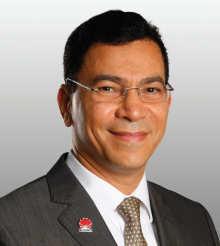
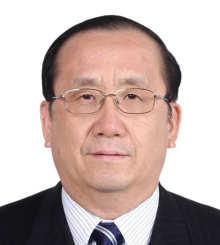
Alaa Elshimy (left) and Lv Gongxun (right).
https://e.huawei.com/topic/2021-event-oil-gassummit/en/index.html
GustoMSC brings Chela Twins to the market
GUSTOMSC HAS BROUGHT the Chela Twins to the market, a cost-competitive pair of cranes improving safe handling underneath the cantilever and reducing total time spent on wells.
In 2019, the first Chela crane was delivered to Maersk Drilling and installed onboard the Maersk Invincible – an ultra-harsh environment GustoMSC CJ70 drilling jack-up design. It has proven its claims since, while operating offshore in the Valhall field for AkerBP. Last October, Velesto Drilling awarded GustoMSC the first two orders for the new and cost-competitive version of the Chela crane; the Chela Twins.
Two cranes are to be installed on NAGA-6, a GustoMSC CJ46 drilling jackup design and owned by Velesto Energy Malaysia. These Chela Twins take the key elements of this first Chela to the South East Asian drilling arena. The cranes work around the well centre in pairs. With their telescopic arms, they provide significant coverage below the cantilever and, depending on the cantilever position, can reach main deck and pick up tools or x-mas trees, for example. The current offering of two telescopic cranes forms a costcompetitive solution that can be applied to the worldwide fleet of standard drilling jack-ups.
The GustoMSC Chela series of multifunctional arms offers an extra hand in operations. Due to its crablike motion characteristics, it can reach below the cantilever as well as reach towards the main deck, providing crane access to an area traditionally blocked by the cantilever when drilling. Chela thus provides a huge advantage in development drilling, infill drilling, and plug and abandonment operations. With this option, wireline operations can take place offline, on any other nearby well, while the derrick is engaged with other well construction operations.
The primary field-proven feature of Chela relates to safe and efficient lifting of well-related parts and tools before and after well construction. With this functionality, a simultaneous operation with the activities performed by the drilling crew at the well centre is possible. Depending on the well programme, total time saved varies between 5% to 15% of total rig days per well.
This proven technology represents a robust opportunity to bring forward ROI for every well drilled. With fewer rig days per well, it directly reduces the industry’s environmental footprint per well drilled.
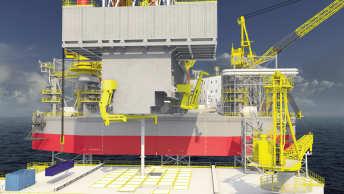
Utilising Chela can save time and costs as well as reducing environmental footprint.
For more information, see nov.com/products/chela-crane
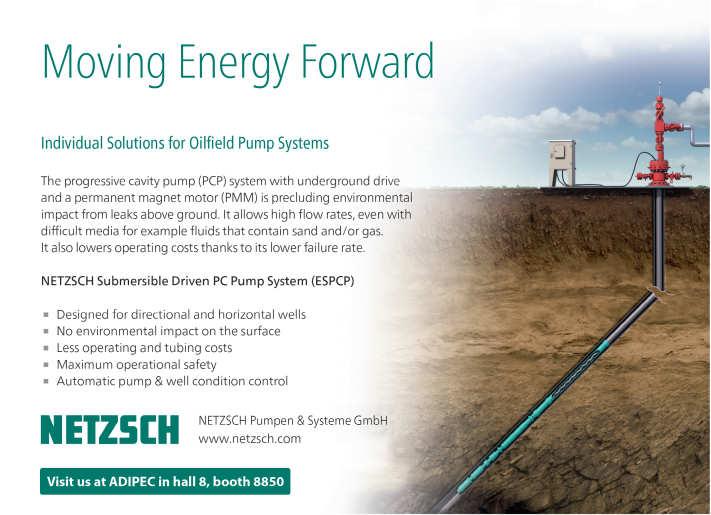
Expanding in the Middle East compressor market
Euro Gas Systems (EGS), the largest compressor packager in Europe dedicated to the upstream industry, is expanding its operations and views the Middle East as a key growth market.
EGS’S STORY HAS been one of continual growth and expansion, as Marc Timis, specialist marketing at EGS, explains.
“EGS was registered as a business early 2010, and in less than one year we managed to ship our first compressor package out of the 1,200 sq. metre start-up facility. A new, 4,900 sq. metre purpose-built assembly plant was constructed and commissioned in 2012. EGS became an official distributor and approved packager of Ariel Corporation in 2013, and OEM for Waukesha and Caterpillar engines in 2014. Due to the company’s continued growth in sales, the assembly plant was expanded to double its original size, reaching 9,800 sq. metres at the end of 2018.
“This year started with the commissioning of the most recent investment, a brand new 1,580 sq. metre fabrication shop for vessels, skids and other weldments. The new fabrication shop is fitted with the latest technology for cutting and welding steel fabrications. Currently we are going through the process of doing the architectural engineering for our next new manufacturing plant, which will be dedicated to manufacturing air cooled heat exchangers (ACHE). Plans are to start construction of this 3,160 sq. metre facility in 2021, with a 2022 completion date.”
The company attributes its fast growth to the hard working, dedicated EGS team. Constant investments in employees, addressing current technical challenges, supporting innovation, and training to ensure a high level of professionalism has been EGS’s number one priority.
“This strategy not only had a direct impact on the quality of the product build, but also made EGS customers fully aware that they are getting exactly what they need, when they need it and exceeding their quality expectations by having the full support of a team that today exceeds 180 employees, and continues to grow,” says Timis.
He goes on to say that EGS has always been focused on customer needs, for both equipment supplied and aftermarket support, by providing on-time top quality products, engineered to customer specifications. The company has taken steps in developing new product lines and has successfully managed, in a short period of time, to rapidly gain market recognition and appreciation as a quality equipment provider, due to continuous investments in tooling, state of the art facilities and people. EGS also works with its customers to ensure proper interface engineering support for the installation of the supplied equipment. Today, its in-house expertise covers the full cycle of product design, manufacture and service support.
“All products are engineered using Autodesk Inventor 3D modelling software,” explains Timis. “From the developed 3D model, an accurate Bill of Materials is imported into our ERP system and from there we can be assured all materials are available in time for scheduled production. During the lead time phase of the major components (compressor, driver, unit control panel), EGS fabricate vessels, skids, piping, etc. so that upon arrival of the major components to our assembly plant we are ready for final assembly and test, which is typically accomplished in a four to six week period.
“Some important aspects established by EGS are the standards in product quality, safety and reliability, developed with a dedicated team, by supporting the customer during the sale and manufacturing with customised services whichever the country of installation of the equipment might be.”
The Middle East region has been one of the main expansion markets for EGS, offering great potential and a constant business stream, even through challenging times.
“Being close to customers by providing full local support motivated us to open up an office in Dubai (UAE) back in 2019. The Dubai office carries both sales and aftermarket service and parts support functionalities, ensuring a more direct and prompt reaction to customer needs,” concludes Timis. n
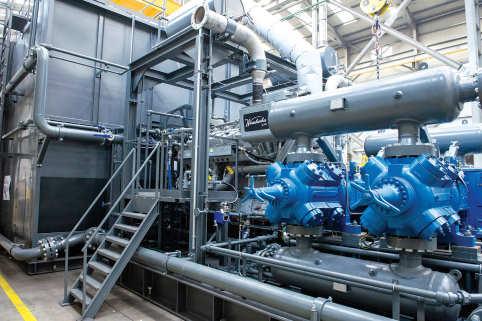
EGS is expanding its facilities.
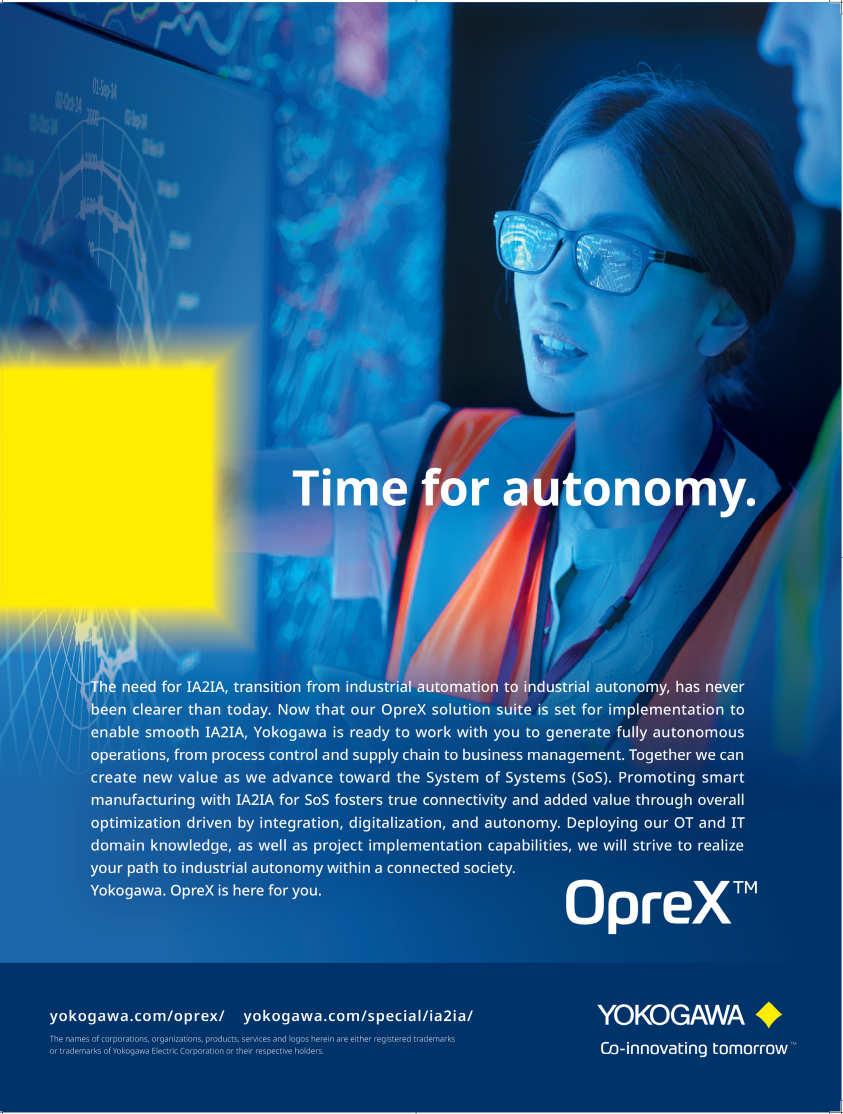
Efficient use of resources for a sustainable future
Interchangeability and sustainability go hand in hand for sand management, says Krzysztof Buchajczuk, senior application engineer, Tendeka.

The 7m jackets (left to right) are fitted with layers of the premium mesh screen jacket with an outer shroud on the outside and a drainage layer underneath.
THE ABILITY TO utilise interchangeable inventory has a major impact on the amount of equipment needed to address multiple projects simultaneously as well as the need for contingency planning, thereby minimising the amount of material used and optimising logistics.
To contribute to a sustainable future for the oil and gas sector, where efficient use of resources is vital, Tendeka has adopted an “inflow plug and play” approach to sand and inflow control with interchangeable equipment supply and fitting.
The process involves the standardisation of equipment while still maintaining flexibility in the design. This means that the same chassis can be used for multiple applications and customised prior to installation to optimise reservoir performance. A smart control framework to manage sand production and inflow control will consider the most efficient combination of screen filter size, type, and mechanical rating selection. The benefits of this approach include: • Improved reservoir performance: flexible
“plug and play” approach allows for final sand and inflow control design to be optimised at the rig site based on the latest reservoir and formation evaluation data • Minimised tooling and machinery adjustments leading to improved manufacturing efficiency • Minimised waste through repeatability and reliability • Efficient supply chain and material management by using metallurgy suitable for producers and injectors • Streamlined screen manufacturing process • Flexibility due to re-use of raw materials when plans change.
Key to the process is supplying the equipment ready to house multiple solutions. Each joint of sand screen suitable for inflow applications comes supplied with between one and four tapped apertures that can be configured to have any combination of valves.
These apertures can accept Tendeka’s FloSure autonomous ICDs, FloRight and FloExtreme ICDs, FloSure injection valves, FloCheck control valves, blanking plugs, or even fully open ports in some cases. These can be changed prior to mobilisation or on site depending on well conditions.
Tendeka’s approach is to standardise the lengths and material grades of the screen jackets utilising inflow control devices which constitute by far, most of the screens produced by the company. This significantly reduces manufacturing costs and waste created during construction.
As an example, by eliminating the necessity to change length and oustide diameter (OD) of every 10 screens, the advanced completions and production optimisation specialist can build around 35% more screens per day than if a customised design was needed. Most notably, the percentage of custom-built screen designs beyond the proposed scope declines each year due to this “plug and play” philosophy.
This agile approach can enhance decisionmaking to select or swap, at the most appropriate interval, inflow, outflow or check valve devices to counter saturation, possible sand production, porosity, and permeability, at any time. It is a gamechanging ability for an industry now more focused than ever on efficient, sustainable and optimum performance. n
It is a gamechanging ability for an industry focused on efficient, sustainable and optimum performance.”
To find out more, please visit: www.tendeka.com







